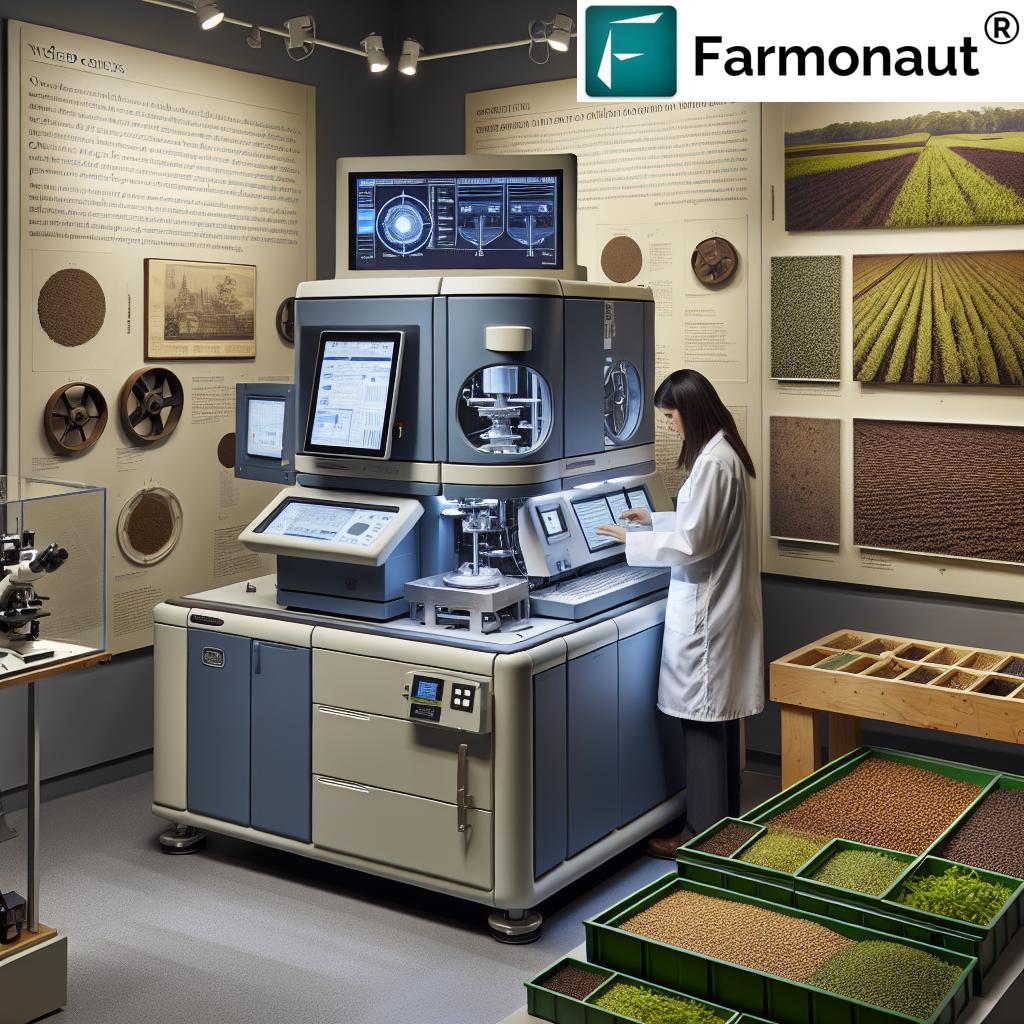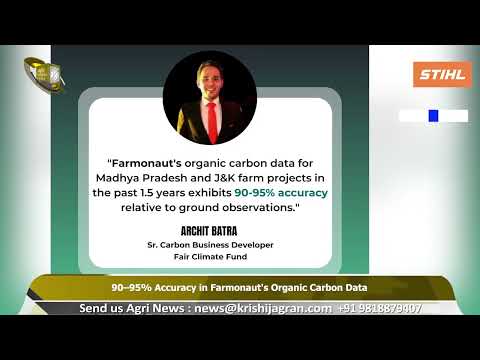Revolutionizing Weed Control: Precision Agriculture Technology for Automated Seed Counting in Arkansas
“Automated seed counting technology can tally thousands of weed seeds in seconds, drastically outpacing manual methods.”
In the vast fields of Arkansas, a quiet revolution is taking place. As we step into a new era of precision agriculture, we at Farmonaut are excited to explore the groundbreaking advancements in weed control strategies that are reshaping the landscape of modern farming. Today, we’re delving into the world of automated seed counting methods and their profound impact on agricultural research and productivity.
The Dawn of Automated Seed Counting in Agriculture
Imagine a world where the tedious task of counting thousands of tiny weed seeds is accomplished in mere seconds. This is no longer a dream but a reality, thanks to innovative precision agriculture technology. The introduction of computerized particle analyzers has transformed the way we approach weed science and control.
In the heart of America’s agricultural belt, researchers and farmers alike are embracing this new technology to revolutionize their approach to weed management. But why is this so important? Let’s dig deeper into the soil of this innovation.

The Importance of Weed Seed Production Monitoring
Weed control is a critical aspect of successful crop production. To effectively manage weeds, it’s crucial to understand their lifecycle, particularly their seed production. Monitoring weed seed production serves several key purposes:
- Evaluating herbicide effectiveness
- Optimizing crop yields
- Developing sustainable weed management strategies
- Predicting future weed infestations
Traditionally, weed scientists and agronomists have relied on manual counting methods to estimate seed production. However, this process is time-consuming, labor-intensive, and prone to human error. Enter the era of automated seed counting.
The Science Behind Automated Seed Counting
At the core of this revolutionary technology lies the principle of shadow imaging. Here’s how it works:
- Seeds are fed into the computerized particle analyzer
- A high-speed camera captures images of the seeds as they pass through
- The analyzer’s software uses these shadow images to count and measure each seed
- Results are produced in seconds, providing accurate counts and size distributions
This technology can accurately count and analyze thousands of seeds per minute, a task that would take hours or even days using traditional methods.
Comparing Traditional and Automated Seed Counting Methods
| Aspect | Manual Counting | Automated Counting |
|---|---|---|
| Time Required | Hours to days | Seconds to minutes |
| Accuracy | ~80-90% | >99% |
| Sample Size Capacity | Hundreds | Thousands to millions |
| Labor Intensity | High | Low |
| Data Analysis Capabilities | Limited | Extensive |
| Cost-Effectiveness | Low | High |
| Application in Precision Agriculture | Limited | Extensive |
As we can see, the automated method offers significant advantages in terms of speed, accuracy, and scalability.
Impact on Agricultural Research and Productivity
The introduction of automated seed counting technology has far-reaching implications for agricultural research and farm productivity:
- Enhanced Research Efficiency: Researchers can process larger sample sizes in less time, leading to more comprehensive studies.
- Improved Herbicide Evaluation: Accurate seed counts allow for better assessment of herbicide effectiveness.
- Data-Driven Decision Making: Farmers and agronomists can make more informed decisions about weed control strategies.
- Resource Optimization: By understanding weed populations more accurately, resources can be allocated more efficiently.
At Farmonaut, we’re committed to bringing such innovative technologies to farmers worldwide. Our satellite-based crop health monitoring system complements these advancements, providing a comprehensive approach to precision agriculture.
Addressing Climate Change Challenges
As we face the growing challenges posed by climate change, precision agriculture technologies like automated seed counting become increasingly important. These tools help farmers adapt to changing conditions by:
- Enabling more precise weed control measures
- Reducing the need for chemical herbicides
- Supporting sustainable farming practices
- Improving crop resilience in the face of environmental stresses
By integrating these technologies with Farmonaut’s satellite-based monitoring systems, we can provide farmers with a powerful toolkit for navigating the complexities of modern agriculture.
“Shadow imaging technology in agriculture enables precise counting of over 30,000 weed seeds per minute for improved herbicide effectiveness evaluation.”
The Role of Precision Agriculture in Sustainable Weed Management
Sustainable weed management is a critical component of modern agriculture, and precision technologies play a pivotal role in achieving this goal. Here’s how automated seed counting contributes to sustainable practices:
- Targeted Herbicide Application: By accurately assessing weed populations, farmers can apply herbicides more precisely, reducing overall chemical use.
- Integrated Pest Management: Detailed weed data supports more effective integrated pest management strategies.
- Conservation of Beneficial Species: Precise weed control helps protect beneficial plants and insects in the ecosystem.
- Soil Health Preservation: Reduced tillage and herbicide use contribute to better soil health and structure.
At Farmonaut, we recognize the importance of these sustainable practices. Our satellite-based crop monitoring system complements these efforts by providing real-time data on crop health and soil conditions, enabling farmers to make informed decisions about resource management.
Explore Farmonaut’s API for advanced agricultural insights
The Future of Weed Science and Farming Practices
As we look to the future, the integration of automated seed counting with other precision agriculture technologies promises to revolutionize farming practices. Here are some exciting developments on the horizon:
- AI-Driven Weed Management: Machine learning algorithms could predict weed outbreaks based on historical seed count data.
- Drone-Based Seed Counting: Combining aerial imagery with seed counting technology for large-scale field assessments.
- Robotic Weed Control: Precision robots using seed count data to target and remove weeds without chemicals.
- Predictive Modeling: Advanced models using seed count data to forecast crop yields and optimize planting strategies.
These advancements align perfectly with Farmonaut’s mission to make precision agriculture accessible and affordable for farmers worldwide.

Implementing Automated Seed Counting in Arkansas Agriculture
Arkansas, known for its rich agricultural heritage, is at the forefront of adopting these innovative technologies. Here’s how automated seed counting is being implemented in the Natural State:
- Research Partnerships: Universities in Arkansas are collaborating with technology providers to refine seed counting methods.
- Extension Services: Agricultural extension offices are educating farmers on the benefits of automated seed counting.
- Field Trials: Large-scale field trials are demonstrating the effectiveness of precision weed management based on accurate seed counts.
- Policy Support: State agricultural policies are evolving to support the adoption of precision agriculture technologies.
These efforts are transforming Arkansas into a model for innovative agricultural practices, setting an example for other regions to follow.
Check out our API Developer Docs for seamless integration
The Economic Impact of Precision Weed Control
The adoption of automated seed counting and precision weed control technologies has significant economic implications for farmers and the agricultural industry as a whole:
- Reduced Input Costs: More targeted herbicide application leads to lower chemical expenses.
- Increased Crop Yields: Effective weed management results in higher crop productivity.
- Labor Savings: Automation reduces the need for manual weed control efforts.
- Market Competitiveness: Farms using precision technologies can produce crops more efficiently, gaining a competitive edge.
By leveraging Farmonaut’s satellite-based crop monitoring alongside these weed control technologies, farmers can maximize their economic benefits while practicing sustainable agriculture.
Overcoming Challenges in Adoption
While the benefits of automated seed counting are clear, there are challenges to widespread adoption that need to be addressed:
- Initial Investment: The cost of acquiring advanced equipment can be a barrier for some farmers.
- Technical Expertise: Training is required to effectively use and interpret data from these technologies.
- Integration with Existing Systems: Ensuring new technologies work seamlessly with current farm management practices.
- Data Management: Handling and analyzing large volumes of seed count data efficiently.
At Farmonaut, we’re committed to addressing these challenges by providing user-friendly interfaces, comprehensive training resources, and seamless integration capabilities with our satellite-based monitoring systems.
The Role of Education and Outreach
Education plays a crucial role in the successful implementation of automated seed counting and precision agriculture technologies. Here’s how various stakeholders are contributing to this educational effort:
- Universities: Developing curricula that incorporate precision agriculture technologies.
- Agricultural Associations: Organizing workshops and demonstrations for farmers.
- Technology Providers: Offering training programs and support for their products.
- Government Agencies: Providing resources and grants for agricultural technology education.
Farmonaut supports these educational initiatives by offering comprehensive guides and tutorials on using our satellite-based crop monitoring system in conjunction with other precision agriculture tools.
Global Implications of Precision Weed Control
The advancements in automated seed counting and precision weed control have implications that extend far beyond Arkansas or even the United States. As we face global challenges in food security and environmental conservation, these technologies offer promising solutions:
- Increased Global Food Production: More efficient weed control can lead to higher crop yields worldwide.
- Reduced Environmental Impact: Precision technologies minimize the use of herbicides, benefiting ecosystems globally.
- Technology Transfer: Innovations in developed countries can be adapted for use in developing nations.
- Climate Change Adaptation: Precision agriculture tools help farmers adapt to changing climate conditions across different regions.
Farmonaut’s global perspective aligns with these broader implications, as we strive to make our satellite-based agricultural solutions accessible to farmers around the world.
Integrating Automated Seed Counting with Other Precision Agriculture Technologies
The true power of automated seed counting is realized when it’s integrated with other precision agriculture technologies. This synergy creates a comprehensive approach to farm management:
- GPS-Guided Equipment: Combining seed count data with GPS-guided sprayers for ultra-precise herbicide application.
- Soil Sensors: Correlating weed populations with soil conditions for more informed management decisions.
- Crop Yield Monitors: Analyzing the relationship between weed pressure and crop yields for optimized strategies.
- Weather Stations: Integrating climate data with weed growth models for predictive management.
Farmonaut’s satellite-based crop monitoring system complements these technologies, providing a bird’s-eye view of field conditions that can be correlated with ground-level data from automated seed counting and other precision tools.
The Impact on Agricultural Research and Innovation
Automated seed counting is not just transforming farm practices; it’s also revolutionizing agricultural research. Here’s how this technology is advancing the field of agronomy:
- Accelerated Studies: Researchers can conduct large-scale studies in a fraction of the time previously required.
- Enhanced Accuracy: More precise data leads to more reliable research outcomes.
- New Research Areas: The technology opens up possibilities for studies that were previously impractical due to time constraints.
- Interdisciplinary Collaboration: Engineers, computer scientists, and agronomists are working together to further improve the technology.
These advancements in research contribute to the continuous improvement of agricultural practices, aligning with Farmonaut’s commitment to innovation in the agricultural sector.
FAQs About Automated Seed Counting and Precision Weed Control
Q: How accurate is automated seed counting compared to manual methods?
A: Automated seed counting is significantly more accurate, with error rates often less than 1%, compared to manual counting which can have error rates of 10-20%.
Q: Can automated seed counting technology distinguish between different types of seeds?
A: Yes, many advanced systems can differentiate between seed types based on size, shape, and other characteristics.
Q: How does automated seed counting contribute to sustainable agriculture?
A: By enabling more precise weed management, it reduces the need for herbicides, minimizes soil disturbance, and supports integrated pest management strategies.
Q: Is automated seed counting technology affordable for small-scale farmers?
A: While the initial investment can be significant, many institutions offer shared access or services. The long-term benefits often outweigh the costs even for smaller operations.
Q: How does Farmonaut’s technology complement automated seed counting?
A: Farmonaut’s satellite-based crop monitoring provides broader field-level data that can be integrated with the detailed weed population data from automated seed counting, offering a comprehensive view of crop health and weed pressure.
Conclusion: Embracing the Future of Weed Control
As we’ve explored throughout this article, automated seed counting and precision weed control technologies are revolutionizing agriculture in Arkansas and beyond. These innovations promise more efficient, sustainable, and productive farming practices, addressing challenges from climate change to food security.
At Farmonaut, we’re excited to be part of this agricultural revolution. Our satellite-based crop monitoring system complements these ground-level precision technologies, offering farmers a comprehensive toolkit for modern agriculture. By combining the bird’s-eye view of satellite imagery with the detailed insights from automated seed counting, we’re helping to create a more sustainable and productive future for farming.
As we move forward, the integration of these technologies will continue to shape the landscape of agriculture, driving innovation, sustainability, and prosperity for farmers worldwide. The future of weed control is here, and it’s more precise, efficient, and effective than ever before.






